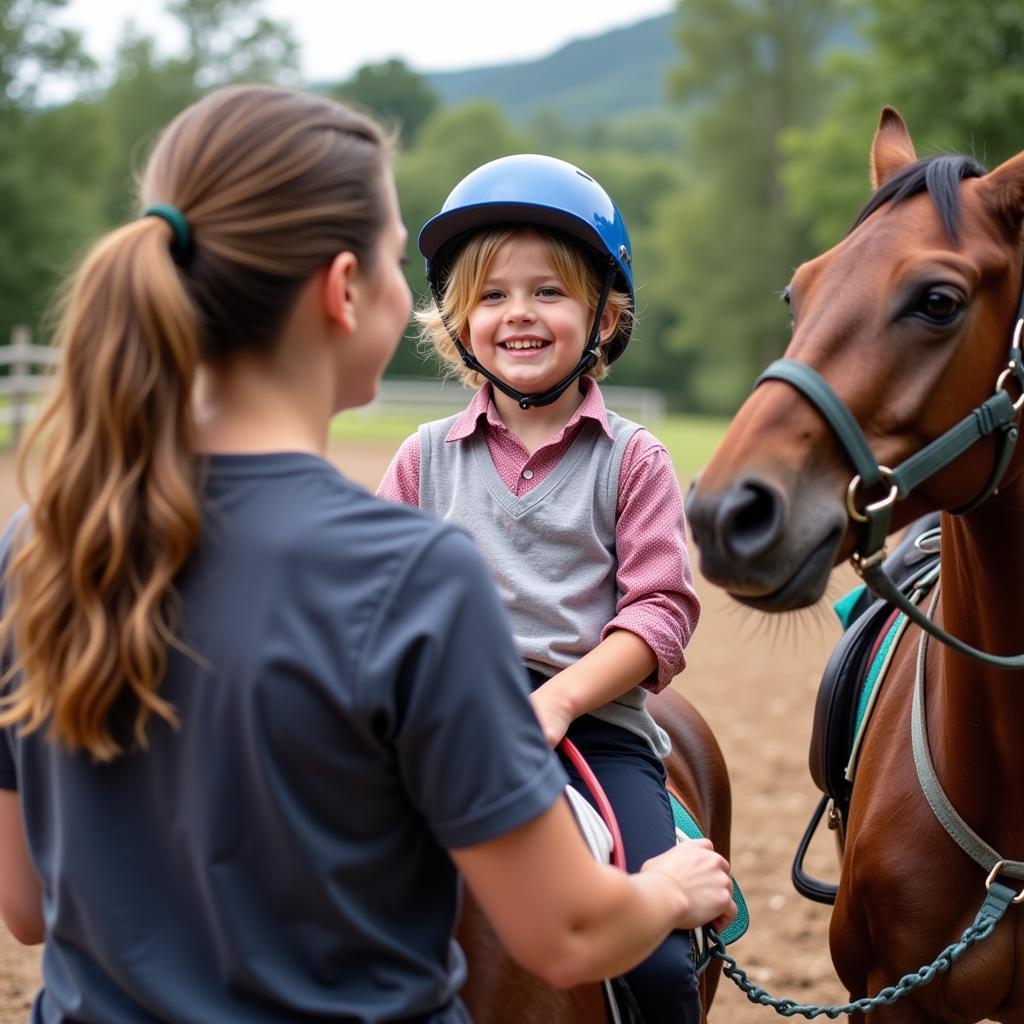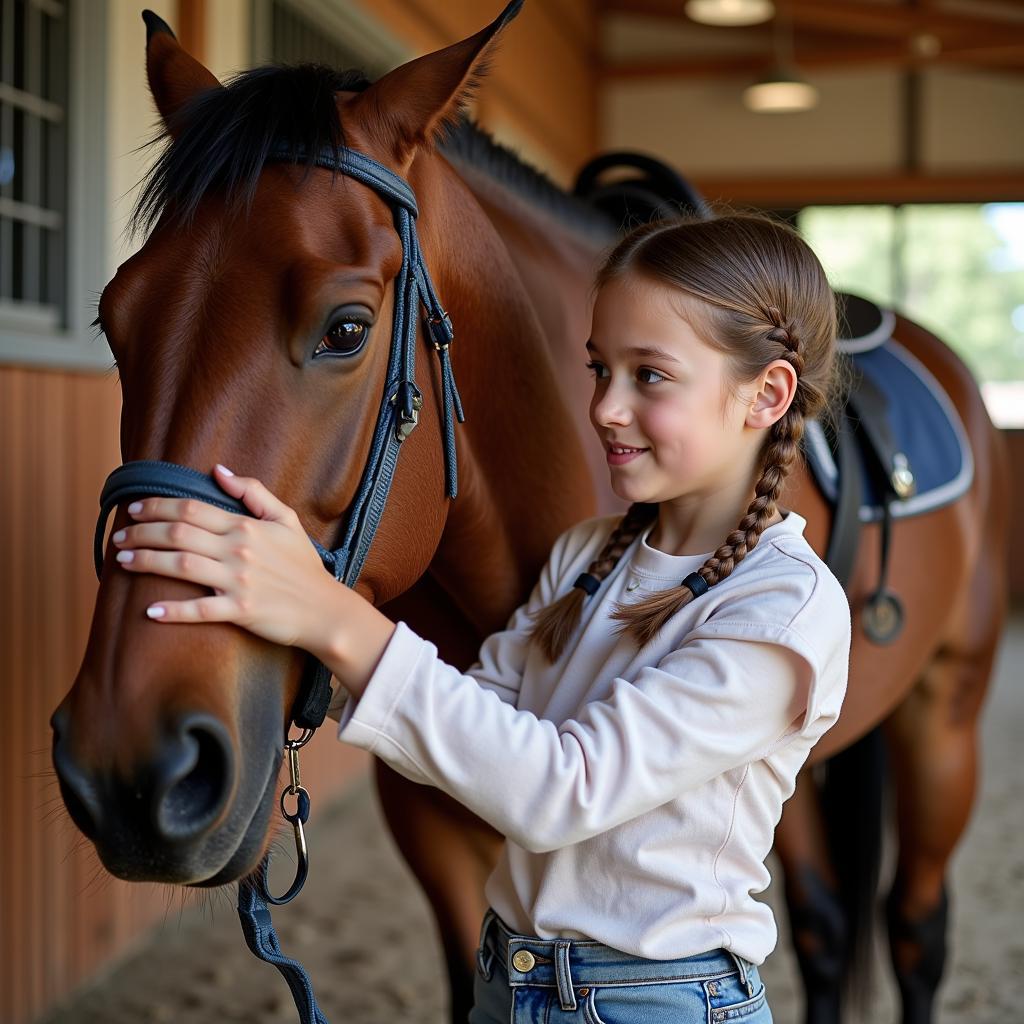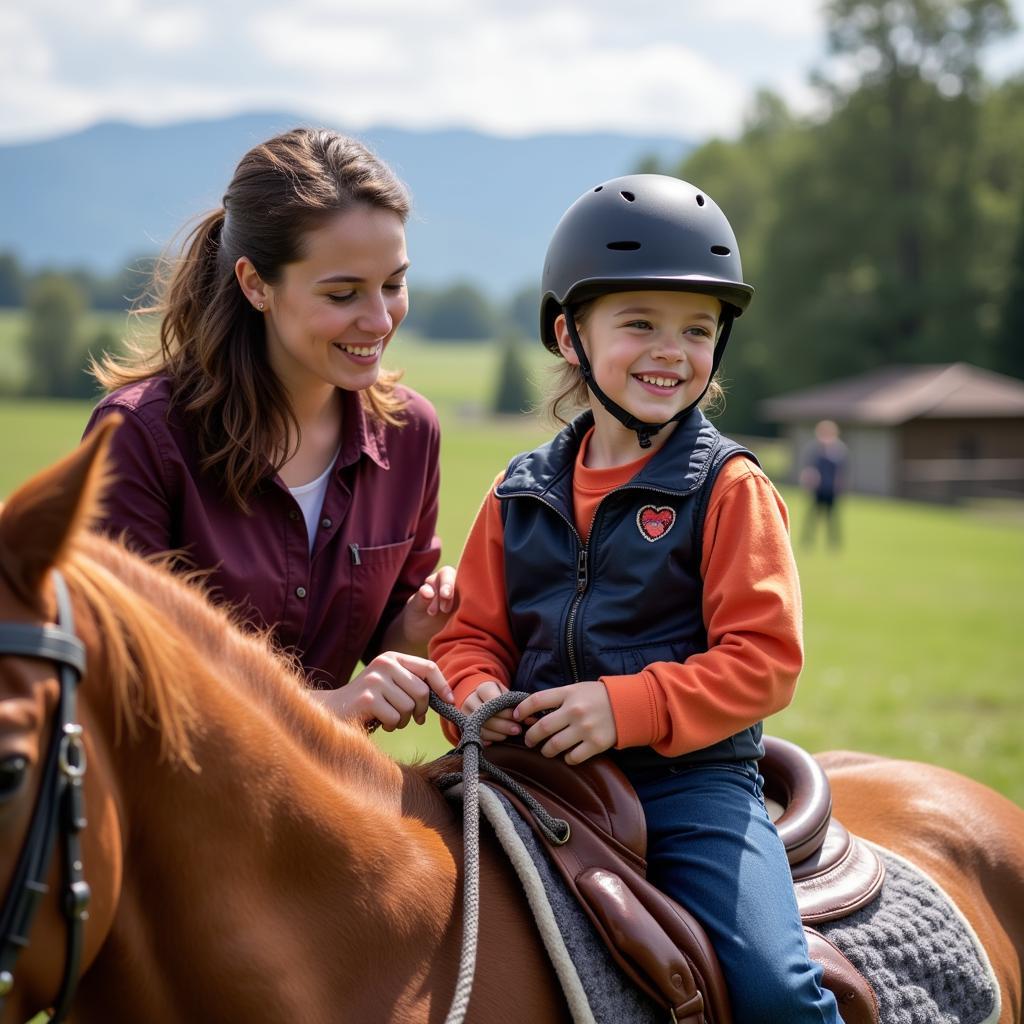Finding effective therapeutic interventions for individuals with autism spectrum disorder (ASD) can be a challenging journey. Many parents and caregivers are turning to alternative therapies like horse riding, also known as equine-assisted therapy, to help their loved ones thrive. If you’re searching for “Horse Riding Therapy For Autism Near Me,” you’re in the right place. This comprehensive guide explores the benefits, considerations, and resources to help you navigate the world of equine therapy for autism.
 Child with Autism Smiles During Horse Riding Therapy Session
Child with Autism Smiles During Horse Riding Therapy Session
Understanding Horse Riding Therapy for Autism
Horse riding therapy is a powerful intervention that harnesses the unique bond between humans and horses to promote physical, emotional, and social growth in individuals with autism. It’s a multifaceted approach involving activities like grooming, leading, and riding horses under the guidance of qualified professionals.
The Science-Backed Benefits
Why is horse riding therapy gaining popularity for autism? Research suggests a multitude of benefits, including:
- Improved Social Interaction: Interacting with horses can enhance social skills, such as eye contact, communication, and turn-taking, in individuals with ASD.
- Enhanced Sensory Processing: The rhythmic movement of the horse provides vestibular and proprioceptive input, which can help regulate sensory sensitivities common in autism.
- Boosted Motor Skills: Riding strengthens core muscles, improves balance, and enhances coordination, leading to better motor control and body awareness.
- Increased Emotional Regulation: The calming nature of horses can reduce anxiety, promote relaxation, and foster emotional regulation in individuals with ASD.
 Teenager with Autism Brushes Horse During Therapy Session
Teenager with Autism Brushes Horse During Therapy Session
Finding Horse Riding Therapy for Autism Near You
1. Consult with Your Healthcare Team: Start by discussing horse riding therapy with your child’s doctor or therapist. They can assess its suitability and refer you to reputable programs.
2. Search Online Directories: Utilize online directories like the Professional Association of Therapeutic Horsemanship (PATH Intl.) to locate certified centers in your vicinity.
3. Contact Local Equestrian Centers: Reach out to equestrian centers and stables in your area. Inquire about their experience with therapeutic riding programs for autism.
4. Join Support Groups: Connect with other parents and caregivers of children with autism. Online forums and local support groups can provide valuable insights and recommendations.
Choosing the Right Program
Not all horse riding therapy programs are created equal. Consider these factors when making your decision:
- Certification and Accreditation: Ensure the program and instructors are certified by reputable organizations like PATH Intl.
- Individualized Approach: Opt for programs that offer personalized therapy plans tailored to your child’s unique needs and goals.
- Safety Protocols: Prioritize programs with stringent safety measures in place, including qualified staff, well-trained horses, and appropriate riding equipment.
What to Expect During a Session
A typical horse riding therapy session involves:
- Grooming and Tacking: The session often begins with grooming and tacking the horse, allowing the individual to interact with the animal and learn basic horse care.
- Riding Activities: Under the guidance of a therapist, the individual engages in various riding activities designed to address specific therapeutic goals.
- Cool Down and Debriefing: The session concludes with a cool-down period for the horse and a debriefing session for the individual to discuss their experience.
 Instructor Guides Horse During Autism Therapy Session
Instructor Guides Horse During Autism Therapy Session
Making the Most of Horse Riding Therapy
To maximize the benefits of horse riding therapy, consider these tips:
- Consistency is Key: Regular and consistent sessions are crucial for individuals to build rapport with the horses and make progress toward their goals.
- Open Communication: Maintain open communication with the therapists. Share any observations, concerns, or progress you notice in your child.
- Celebrate Small Victories: Every step, no matter how small, is a reason to celebrate. Encourage and praise your child’s efforts and achievements throughout the journey.
Conclusion
Finding effective therapies for individuals with autism requires exploration and dedication. Horse riding therapy offers a unique and promising avenue for growth and development. By understanding the benefits, researching programs, and prioritizing safety, you can empower your loved one to experience the transformative power of equine therapy. If you’re searching for “horse riding therapy for autism near me,” don’t hesitate to reach out. We’re here to provide guidance and support every step of the way.
FAQs About Horse Riding Therapy for Autism
1. What age is appropriate for horse riding therapy?
Horse riding therapy can benefit individuals of all ages, from young children to adults. Programs often cater to specific age groups and abilities.
2. Is horse riding therapy covered by insurance?
Insurance coverage for horse riding therapy varies depending on the provider and plan. Contact your insurance company to inquire about coverage options.
3. What should my child wear for a horse riding therapy session?
Comfortable, weather-appropriate clothing and closed-toe shoes with a small heel are recommended for safety and comfort.
4. Can parents observe the therapy sessions?
Most programs welcome parental observation, either from designated viewing areas or with active participation, depending on the program’s guidelines.
5. How long does it take to see results from horse riding therapy?
The timeframe for noticeable results varies depending on individual needs and therapy goals. Consistency and patience are key.
Need more information about horse riding therapy for autism? Explore these related articles:
- The Benefits of Animal-Assisted Therapy for Autism
- Finding the Right Therapy for Your Child with Autism
- Understanding Autism Spectrum Disorder: A Parent’s Guide
Ready to discuss horse riding therapy for your loved one? Contact Justus Horses USA today! Call us at 0772127271, email us at [email protected], or visit our center located at QGM2+WX2, Vị Trung, Vị Thuỷ, Hậu Giang, Việt Nam. Our compassionate team is available 24/7 to answer your questions and provide personalized support.